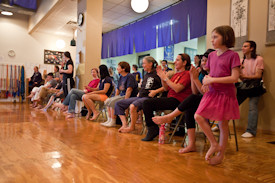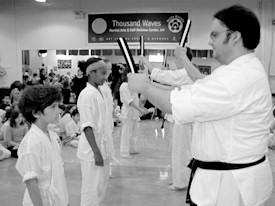2020 February
2018 December August June February
2017 December September June March
2016 November August June March
2015 December October July May February
2014 December October July April February
2013 December October August May February
2012 December September July April February
2011 December September July April February
from the February, 2011 issue of Kiai!
The Journey to Black Belt:
What You as a Parent Can Do to Help your Child Reach the Top
by Co-Executive Director and Jun Shihan Nancy Lanoue
It truly takes a village – and 4 to 7 years - to transform a young, awkward attention-challenged beginner karate student into a poised, confident, self-disciplined black belt leader. Several things have to happen for the journey to even get started. A child must have a spark of interest, someone must be able to bring them to the dojo, and the teachers must succeed in somehow making the hard work of learning a complex art seem fun and interesting. After that, our Seido ranking system kicks in, planting and nurturing the seed of commitment and its connection to achieving personal goals.
 New members earn their first belt patch (and the youngest kids an orange belt) solely by coming to a certain number of classes. These initial rewards that are relatively easy-to-earn prepare them to take the next big step in their training –to be able to independently show what they have learned and have language to describe it.
New members earn their first belt patch (and the youngest kids an orange belt) solely by coming to a certain number of classes. These initial rewards that are relatively easy-to-earn prepare them to take the next big step in their training –to be able to independently show what they have learned and have language to describe it.
For blue belt and all ranks beyond it, required minimum attendance is still part of the process, but the real passage comes by passing your “pre-test.” This is a short, 1-on-1 evaluation conducted by a lead teacher before, during, or immediately after class during the two weeks prior to each scheduled test.
At this point, parents’ involvement usually steps up a notch. To pass their pre-test, students need a Thousand Waves study guide. This textbook, available for $20 at the front desk, tells kids what they need to know to move from level to level and facilitates independent practice at home. It also has a glossary of terms, in English and Japanese, which are used in class. Our study guide is written on the 4th grade level, so Junior and young Youth Program members will need help from parent-readers to access this resource.
As children move through the color belt ranks, it is common for them to run into obstacles on their path to black belt. These might include boredom when the thrill of the new is gone; fear of some new part of training or of graduating to the Youth or Teen program; or competition from other after-school activities, most often sports, for time to train.
 At these junctures, parents have a choice. They can let their child drift away, which is almost guaranteed to result in them quitting and forfeiting the investment that the whole family made in their karate training. Or they can bring the child in for a parent / student / teacher conference, which frequently results in the child getting re-motivated to persevere on their path to black belt. Needless to say, we are happy to make ourselves available for these conversations, since we too have made a big investment in each child who trains at Thousand Waves.
At these junctures, parents have a choice. They can let their child drift away, which is almost guaranteed to result in them quitting and forfeiting the investment that the whole family made in their karate training. Or they can bring the child in for a parent / student / teacher conference, which frequently results in the child getting re-motivated to persevere on their path to black belt. Needless to say, we are happy to make ourselves available for these conversations, since we too have made a big investment in each child who trains at Thousand Waves.
One of the most significant indicators of whether or not a child will be among the few who make it to black belt is consistency of training. When a child’s attendance drops below two times a week on average, two negative consequences tend to happen – the student is not successful in remembering the Seido syllabus and they feel “behind.” And they have weaker social and emotional ties to teachers and fellow students which makes them feel like an outsider - no fun for anyone. Those children who don’t train with us over the summer experience a similar challenge when they come back in the fall and have to reintegrate into the community.
What rewards might there be for you, the parent, from investing your valuable time and resources to help your child earn a black belt? Perhaps the comfort of knowing that your child will have a caring and committed community to support and guide them when being a teenager gets hard. Or that they have effective self-defense and peacemaking skills to help them safely navigate conflict and violence should it occur. Or that their early athleticism and physical fitness is thought to help them maintain healthy lifestyle habits as an adult.
Finally, they can (and do) note their black belt achievement on applications for high school and college, which helps them stand out from the crowd. Very few young people can say that they have stuck with anything positive, challenging, and healthy for such a long time.
